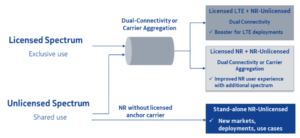Introduction
The advent of modern emerging industrial technologies, known as Industry 4.0, is an evolutionary trend of automation and data exchange in industrial technology after mechanization (First Industry), electrification (Second Industry), and digitalization (Third Industry).
The fourth industrial revolution focuses on incorporating IoT (Industrial IoT or IIoT) in the domain of industrial automation with the key purpose of increasing the competitiveness of industrial automation verticals such as manufacturing, energy, utilities, oil and gas refineries, and transportation.
Communication for automated and connected industries needs strict criteria in terms of latency, availability, throughput, and the number of devices for diverse Industry 4.0 equipment.
In support, 5G NR access technology is actively working on ultra-reliable low-latency communications (URLLC), enhanced mobile broadband (eMBB) for use cases like extended reality (XR), connectivity for massive machine-type communications (mMTC) and expansion to the unlicensed spectrum for the Industry 4.0 applications.

Industry 4.0
5G Use Cases for Industry 4.0

5G Use Cases for Industry 4.0
5G New Radio in the Unlicensed band (NR-U)
New Radio in the Unlicensed band (NR-U) is a new NR Release 16 mode of operation that has the capability to offer the necessary technology for cellular operators to integrate the unlicensed spectrum into 5G networks.
The 3GPP introduced NR-U in the unlicensed sub-7 GHz bands in 3GPP Release 16 to provide a necessary technology supporting the future industry and society. NR-U is a groundbreaking transformation of LTE in the Unlicensed band (LTE-U)/Licensed Assisted Access (LAA) from 4G LTE to 5G NR and provides an alternative to mitigate the bandwidth scarcity problem by leveraging the unlicensed spectrum in NR operations.

Spectrum Priorities in Rel-16
NR-U enables both uplink and downlink operation in unlicensed bands, supporting 5G advanced features of ultra-high-speed, high bandwidth, low latency, and improvement in the reliability of wireless communications, which is essential to address massive-scale and highly diverse future industrial networks.
Unlicensed spectrum complements licensed, boosting capacity, and improving data connectivity. Also, it plays a crucial role in realizing the industrial communication goals of 5G and beyond by offering ultra-high-speed, high capacity, low latency, and improvement in the reliability of wireless communications.

NR-U
Deployment modes of NR-U
The 3GPP defined three main industrial deployment scenarios for NR-U: Carrier Aggregation mode, Dual Connectivity mode, and Standalone mode.
Carrier Aggregation mode is based on LTE-LAA in Release-13 where the unlicensed spectrum is used to augment downlink capacity, whereas the uplink and control plane signals are passed via the licensed carrier.
Dual Connectivity mode is based on the design of LTE-extended LAA (eLAA) in Release-14 which supports both uplink and downlink data-plane traffic over the unlicensed spectrum, whereas the control plane is anchored over the licensed band.
A standalone mode is a novel approach in Release-16. In standalone, NR-U is expected to work in the unlicensed spectrum without being anchored to any licensed carrier. Thus, NR-U is attracting much interest in industrial networks since it allows the removal of the dependency on public networks.
|
Carrier Aggregation |
Dual Connectivity |
Standalone Mode |
|
| Standardization |
LTE Release 13 |
LTE Release 14 |
LTE Release 15 |
| Frequency |
5 GHz |
5 GHz |
2.4, 3.5, 5, 6, 37, 60 GHz |
| Frequency band |
License + unlicensed |
License + unlicensed |
Unlicensed |
| Protocol |
LTE |
LTE |
NR |
| Aggregated bandwidth |
80MHz |
80MHz |
800MHz |
|
Streams |
Downlink | Uplink + Downlink |
Uplink + Downlink |
NR-U Challenges
A standalone system must satisfy the following primary requirements to be viable for operation in the unlicensed band:
- It must stick to any applicable regulatory requirements for unlicensed band operation such as limits on transmit power, spectral density, and channel occupancy.
- It must achieve fair coexistence with other nodes of either the same or a different technology, e.g., WiFi. Thus, the realization of standalone
NR-U possesses various regulatory and coexistence challenges from the industrial, as well as the technological perspective.
References
- ETSI
- Nokia, 5G for New Era
- IEEE
- 3GPP RP-142286: 3GPP TSG CT Meeting. Release 13.













